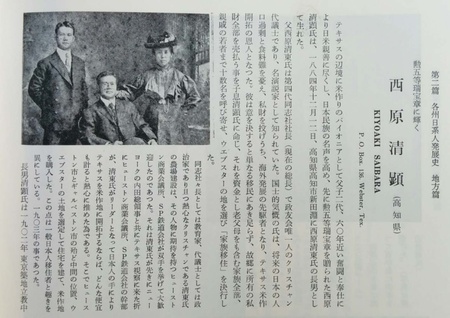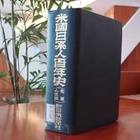"The Centennial History" devotes 36 pages to "Chapter 15: Texas." The Japanese introduced here are different in their activities from the Japanese immigrants who appeared in most of the chapters on other states. In Texas, there were some migrant laborers, but what stands out is the attempt to establish settlements by investing capital from Japan, mainly for rice production.
The book captivates readers with stories about notable activities and unique examples among early immigrants, including those involved in the settlement project.
I will reprint some of these examples below, but first I will summarize the general overview of the Japanese presence in Texas that has been written.
The first recorded relationship between Japanese people and Texas dates back to cotton trade, when the Japan Cotton Company imported Texas cotton directly in 1895. However, it is believed that Japanese sailors who came to the port city of Galveston landed and lived there before that.
In addition, in 1899, geographer and House of Representatives member Shigetaka Shiga traveled to Texas to conduct research in the United States. At the site of the famous Alamo battlefield, a stone monument bearing Shiga's poems was erected.
In 1903, Seiyukai politician and Doshisha University president Nishihara Seito and others settled on the outskirts of Houston to grow rice. Other settlers followed, moving to other parts of the state to grow rice and citrus fruit. Development began in various areas, and eventually a rice-growing boom occurred in Texas.
Hideyoshi Tsuchiya, a pioneer of Japanese people in Texas, lived in El Paso and came to the United States in 1885. Originally a carpenter with great dexterity, he made a living selling bamboo crafts in El Paso and Mexico.
Consul General Uchida creates opportunity for rice cultivation
About the beginnings of rice cultivation in Texas.
"In the early 1900s, the Houston Chamber of Commerce and the state governor of Texas agreed to follow the example of neighboring Louisiana and encourage rice cultivation as a way to develop the state. They sent representatives to New York to ask Consul General Uchida if they could invite people with experience in rice cultivation from Japan, which had been known as a rice country since the country opened its doors to the world. This was in 1903."
In response, Consul General Uchida began to mediate the move. This sparked Kiyohara Seito's interest, and he visited the area. After returning to Japan, he called on people to move to Texas, but there was no response, so he decided to move himself. He sold all of his personal possessions, returned to the United States during the Russo-Japanese War, bought land, and recruited more than 20 people, including his family and the children of prominent families, to move to the suburbs of Webster, south of Houston.
Around this time, Rihei Onishi, who had traveled to the United States as a newspaper correspondent for the Portsmouth Peace Conference following the Russo-Japanese War, also settled in the area to grow rice, around the same time as Nishihara. Later, other Japanese people also settled in the vicinity of Webster and began growing rice.
Among these, Nishihara Seito's farm is described in detail, along with his eldest son Kiyoaki, who took over the farm.
Seito was disappointed that the 1924 US immigration law meant that Japanese people could no longer become naturalized, so he decided to go to Brazil. His successor, Kiyoaki, worked hard as chairman of the Japanese Association of Texas, founding the association and purchasing a Japanese cemetery. After the outbreak of war between Japan and the US, he was interned at Camp Kennedy as an enemy alien, but was allowed to return home after four weeks. This was likely in recognition of his trustworthy reputation and contributions to US-Japan friendship, as well as the importance of increasing food production.
The farm continued to operate after the war, and Kiyoaki's achievements were featured on television and other media in Japan.

Satsuma Oranges and Oil
During the rice-growing boom, some Japanese people who had settled in the Houston area came up with a plan to transplant and grow Japanese mandarin oranges, and a large number of Satsuma mandarin seedlings were imported from Yokohama, sold, and planted, resulting in a boom that rivaled rice cultivation. These mandarin oranges, known as "Satsuma oranges," temporarily became popular from Texas to Alabama.
"At that time, Arai Saburo (Niigata Prefecture) traveled to Japan almost every year to import mandarin orange seedlings on Osaka Shosen steamships, and tens of thousands of Satsuma oranges were planted in Texas. At the time, mandarin orange seedlings purchased from Japan were worth five sages each, and he would grow them and sell them for around 50 sages each, making a huge profit."
Many Japanese also settled in the Beaumont region of eastern Texas amid the rice-growing craze. Among them was Yoshimatsu Kishi, a native of Niigata Prefecture who had experience working in the oil industry in Japan.
"He initially went to America hoping to become a rice farmer, but was unsuccessful. Oil gushed out from every corner of his land, and he was unable to make a fortune due to various obstacles. However, he was one of the unique pioneers who was involved in the oil business in both Japan and the United States until before the war between the two countries."
"At one time, Kishi was highly regarded among Americans as an oil tycoon and earned the honorific title of 'Baron Kishi,' making a living. However, contrary to the previous economic boom, the amount of oil produced was unexpectedly small, and the project ended in a major failure."
Kishi invested large amounts of capital into his business, establishing a colony and contributing to the local community, for which he became well known, but the plantation subsequently shrank.
On the Rio Grande plains on the Mexican border
There are other traces of Japanese presence in Texas besides the above places, which are introduced by region. According to this, after World War I, about 30 Japanese people, including those who disembarked from the ships, lived near the port of Galveston, where foreign ships docked. Japanese people were also active in the historic city of San Antonio and the large city of Dallas.
Many Japanese also settled in the area called the Rio Grande Plain, which borders Mexico by the Rio Grande River, as agricultural immigrants. Some even came from the Mexican side.
It is said that the first person to move there was Miyamoto Heishiro, a native of Chiba Prefecture, in 1908, and after that, other Japanese people from other states came to cultivate vegetables, etc. Among them was a group known as the "Seven Men of Yamato Colony."
In 1919, Kawabata Minoru and seven others purchased land at the Blue Ray Plantation in Brownsville near the river mouth and started farming it, but disbanded in the third year. After the 1921 California Land Law, Japanese people came to Brownsville to inspect the land, which triggered an anti-Japanese movement to "drive the Japs away." After the outbreak of war between Japan and the United States, the FBI began investigating Japanese families all over the plains.
The Japanese Association of El Paso was established in 1915. There were Japanese doctors who were active here before the war.
"After completing his training at the Texas State Medical College in 1923, Furukawa Teiichi (Chiba) passed the state medical examination and opened a clinic in El Paso the following year. He continued to practice in the city ever since, and throughout both the prewar and postwar periods, he was so trusted by Japanese and Mexicans that he was called a private consul. His medical skills were so popular that Mexicans crossed the Mexican border and visited his clinic, and he was looked after like a loving father."
The population of Japanese people in Texas was 13 in 1900, 340 in 1910, and 515 in 1930. It decreased to 458 in 1940, but increased sharply to 4,053 in 1960. (From the census)
(Note: I have used the original text as much as possible, but have made some edits. Titles have been omitted.)
*Next time we will introduce " Japanese people in the three northern central states ."
© 2015 Ryusuke Kawai







